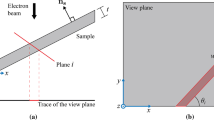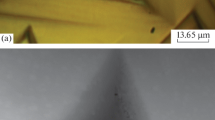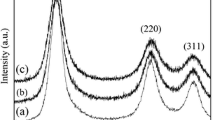Summary
Screw dislocations along the [0001] axis in 6H−SiC single crystals have been studied extensively by Synchrotron White-Beam X-ray Topography (SWBXT), Scanning Electron Microscopy (SEM), and Nomarski Optical Microscopy (NOM). Using SWBXT, the magnitude of the Burgers vector of screw dislocations has been determined by measuring the following four parameters: 1) the diameter of dislocation images in back-reflection topographs; 2) the width of bimodal dislocation images in transmission topographs; 3) the magnitude of the tilt of lattice planes on both sides of dislocation core in projection topographs; and 4) the magnitude of the tilt of lattice planes in section topographs. The four methods show good agreement. SEM results reveal that micropipes in the form of hollow tubes run through the crystal emerging as holes on the as-grown surface, with their diameters ranging from about 0.1 to a few micrometers. Correlation between topographic images and SEM micrographs shows that micropipes are screw dislocations with Burgers vector magnitudes from 2c to 7c (c is the lattice constant along the [0001] axis). There isno were fitted to Frank’s prediction for hollow-core screw dislocations:D =μb2/4π 2 γ, where μ is the shear modulus, and γ is the specific surface energy. Statistical analysis of the relationship betweenD and b2 shows that it is approximately linear, and the constant, γ/μ, obtained from the slope, ranges from 1.1×10−3 to 1.6×10−3 nm.
Similar content being viewed by others
References
Frank F. C.,Acta Cryst.,4 (1951) 497.
Verma A. R., inCrystal Growth and Dislocations (Butterworths, London) 1953, pp. 166–172.
Sunagawa I. andBennema P.,J. Cryst. Growth,53 (1981) 490.
Tanaka H., Uemura Y. andInomata Y.,J. Cryst. Growth,53 (1981) 630.
Krishna A. P., Jiang S. S. andLang A. R.,J. Cryst. Growth,71 (1985) 41.
Golightly J. P.,Z. Krist.,130 (1969) 310.
Komatsu H. andMiyashita S.,Jpn. J. Appl. Phys.,32 (1993) 1478.
Dudley M., Wang S., Huang W., Carter C. H. jr. andTsvetkov V.,J. Phys. D,28 (1995) A63.
Wang S., Ph. D. Thesis, State University of New York at Stony Brook, USA, 1995.
Tanner B. K., Midgley M. andSafa M.,J. Appl. Cryst.,10 (1977) 281.
Klapper H.,J. Appl. Cryst.,9 (1976) 310.
Mardix S., Lang A. R. andBelch I.,Philos. Mag.,24 (1971) 683.
Miltat J., inCharacterization of Crystal Growth Defects by X-Ray Methods, edited byB. K. Tanner andD. K. Bowen (Plenum Press, New York) 1980, p. 408.
Miltat J. E. A. andBowen D. K.,J. Appl. Cryst.,8 (1975) 657.
Kirschstein G. (Chief Editor)Gmelin Handbook of Inorganic Chemistry, 8th edition,Silicon, Supplement, Vol. B2,Properties of Crystalline Silicon Carbide (Springer-Verlag, New York) 1984.
Author information
Authors and Affiliations
Rights and permissions
About this article
Cite this article
Dudley, M., Si, W., Wang, S. et al. Quantitative analysis of screw dislocations in 6H−SiC single crystals. Nouv Cim D 19, 153–164 (1997). https://doi.org/10.1007/BF03040968
Received:
Accepted:
Issue Date:
DOI: https://doi.org/10.1007/BF03040968
PACS
- 61.72.Fg
- Directed observation of dislocations and other defects (etch pits, decoration, electron microscopy, X-ray topography, etc.)




